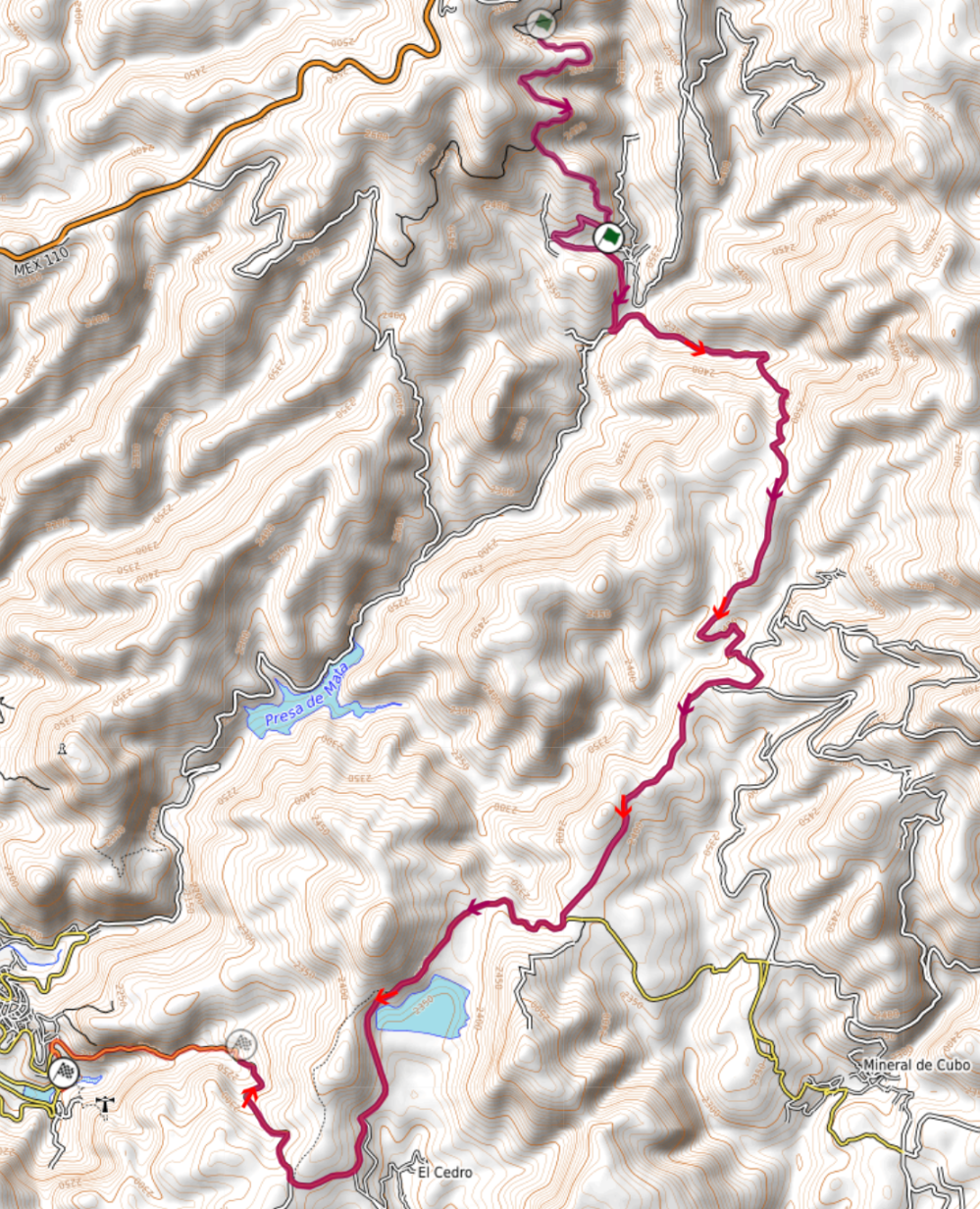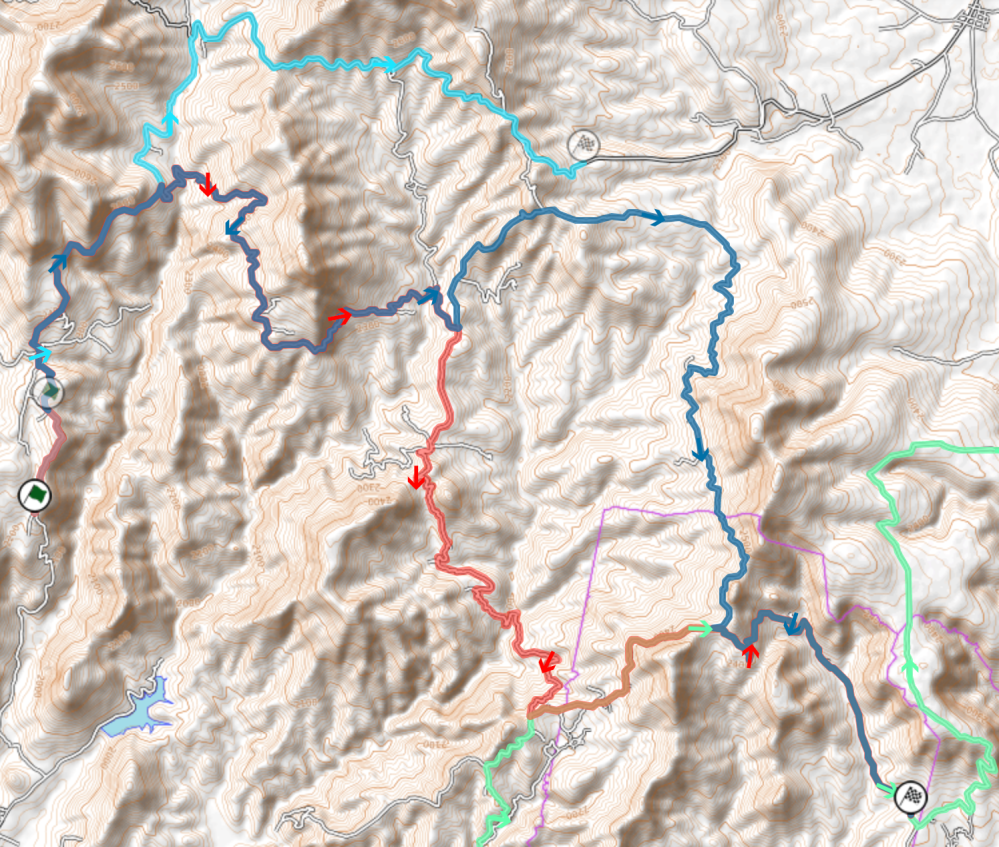In Rally Mexico the challenges include power-eating high altitude and loose gravel for the first cars on the road. In addition, there are always numerous super special stages. This year’s route seems slightly faster than the previous ones.
Rally Mexico 2020 @ rally-maps.com || Cover photo by Richard Simpson / Flickr (C)
Thursday
The shakedown at Llano Grande has been used already for many years. It represents the conditions and road types of the rally quite well with mostly narrower and angular road with a wider section at the end, topped with a water splash.

The action begins in the evening at the familiar SSS1+2 Street Stage GTO in the city of Guanajuato. This stage is known for its tunnel section and roundabout at the end. It has an identical route to last year. Last year there was a problematic ramp jump, but now its location is moved, hopefully working now better. The new thing however is that the whole stage is run twice consecutively.

Friday
The Friday desert stages are largely the same as last year, driven East of Leon and North of Guanajuato.
SS3+7 El Chocolate is the longest stage of the day at 31 km of length. The beginning of the stage ascends almost constantly with has some rough parts and technical sections. After 10 km it becomes narrower and rougher, slow and technical. After 15 km the stage turns onto a wider road but remains still technical. Another big ascension starts at 22 km. The rhythm alternates constantly, but the very ending is surprisingly fast.
Teemu Suninen has been unlucky on El Chocolate for the last two years. Last year his rally ended abruptly after only a few kilometres.
SS4+8 Ortega used to be the ending of El Chocolate still in 2017, but for the last two years they have been driven separately. Thus this is the third year Ortega is driven in the same form.
While El Chocolate is one of the slowest desert stages, Ortega is the fastest of the whole rally, being wide, fast and flowing. It’s also notable that Ortega is also the highest elevated stage of the rally.
In 2018 Elfyn Evans had a high-speed roll on this stage.

SS5+9 Las Minas has served as the power stage for the past two years, but now it acts as the third stage of the Friday loop. For this year the stage is extended from its start, using a route last driven in 2016. The beginning is now at a narrow and tricky passing of a village succeeded by a downhill hairpin and a water splash.

The mountain road remains technical and quite narrow until it meets last year’s start at 2.9 km on a fast-flowing section. After a technical passage the stage joins a wide road at 5.2 km, becoming again fast and flowing, with technical passages at 7.3 km and 10.7 km. Then the stage becomes altogether more technical and soon also narrower. At the end there’s a cobblestone and tarmac section introduced in 2018.
In 2018 the tarmac part contained a chicane, which caused some controversy after Sebastien Ogier received a time penalty for moving the chicane. Last year the chicane was removed, and it remains the same this year.

SSS6 Parque Bicentenario is mostly tarmac super special stage last used in 2014. It has some tight bends and junction turns on partly narrow roads, but apparently no donuts or chicanes, which is nice. The route is slightly altered from 2014, adding a short gravel section

This video at 0:28 shows well the nature of the stage on the narrow park roads.

After the second loop of desert stages, there’s two runs on the SSS10+11 Autódromo de León stage. It’s a twin-car stage which is driven on tarmac more than gravel, unlike most such tests.
Last year Sebastien Ogier had a small moment on the stage.
The day is concluded with SSS12 Street Stage León on a completely new route at the historic downtown of León. What’s interesting is that the stage is only 910 metres long, being most likely the shortest stage ever driven in the history of WRC. The stage has six corners, two of them with donuts, and that’s it. The surface alternates from tarmac to cobblestones during the stage.


Saturday
The Saturday stages are at least partly the same as last year, with just some title swapping and route updates. The stages are situated North and East from Leon, with quite short liaisons.
SS13+16 Guanajuatito is the longest stage of the day at almost 25 km of length. It’s mostly a technical and narrow stage, but it also has some long straights or fast passages. There are also numerous junction turns, but the rhythm or road condition changes at surprising places between the junctions.
Guanajuatito is shortened from last year, meaning that the corner where Esapekka Lappi went off last year is not featured anymore. Instead, the stage turns left, using 770 metres of road last used in this direction on the 2015 version of the stage.
SS14+17 Alfaro has been run once on Sunday morning for the last two years, but this year it is included in the Saturday leg as a double run. The beginning is extended by 1.5 km. The last time this part was used was 2017’s La Calera. After that there’s a technical and spectacular passage with the only junction turn of the stage.
For this year the route has been straightened from its more technical sections, becoming like a highway stage, consisting mostly of wide, fast and flowing roads with only a handful of tighter corners. One particularly tricky place is the downhill at the end of the stage, including the cobblestoned hairpin where Kris Meeke went off in 2018.

SS15+18 Derramadero is a familiar Rally Mexico stage title. The last time this stage appeared on the itinerary was the power stage of 2017.
The beginning is medium wide and angular, with very high speed straights alternating with tight corners. A more technical section begins at 6.6 km. After some hairpins the pace is brought back up. After the junction at 10.3 km the road becomes wider, smoother and more cambered, more fast and flowing.

At 19.9 km the stage deviates onto the new ending introduced last year on the El Brinco stage. It includes first a bit of narrow, bumpy, soft and technical road over a hill, then a wide but soft acceleration onto the new artificial El Brinco jump.
This year the whole rally packs in nine super specials . To conclude Saturday, there’s two more runs of SSS19+20 on the Autodromo de Leon twin-car stage, and then SSS21, another super special with the title Rock And Rally Leon. However, this is more familiar as the Street Stage Leon from the previous years, a very artificial tent stage with a couple of turns on a street.

Sunday
The Sunday stages are driven in the same area as the Saturday stages. All three stages are run only once in the rally, but all of them feature some sections driven already twice earlier in the rally. The roads in Mexico are firm-based and the entry lists short, so this doesn’t cause any problems of road deterioration. However, the grip level will vary when the shared sections alternate with the single-run ones.
Conversely to Alfaro, SS22 Otates is now driven only once on Sunday being a partial repeat of Alfaro. It’s most likely the slowest and most technical stage of Rally Mexico. Last year these technical sections were driven twice, emphasizing the faster nature of this year’s rally. Otates is again the longest stage of the rally at 33.5 km of length. It’s also the longest stage of the season, at least until Safari Rally (whose route we don’t know yet as of writing this).
The beginning is shared from Alfaro, driven now for the third time. At 6.1 km there’s a sudden hairpin junction turn to a very small road, which ends the shared section. At 15.5 km the stage turns onto a road which hasn’t been driven ever before in the rally. It appears to be fast at first, then very technical.

At 24.1 km the stage turns onto a section familiar from Duarte – Derramadero from 2018, a narrow but fast and flowing road with a steep uphill. The last 5.9 km are also the same as last year. On this descending section the stage becomes more technical with a quite fast but bumpy passage near the end.
This video is from the very last corners of the stage, featuring a very long view of the cars.
SS23 San Diego has a new stage title, but its roads are familiar. The first half is actually a reverse run from Saturday’s Derramadero, meaning it’s driven for the third time. The last time this direction was used was 2018’s Duarte – Derramedero. The begin is medium wide, fast and angular with only a few technical corners.

At 7.7 km the shared section with the Derramadero stage ends and there’s a junction turn at the town of Derramadero. After that the road is more rocky rough. The last 3.9 km of the stage haven’t been used since 2011’s Comanjilla stage. It’s a bit more technical than the beginning, descending constantly.
SS24 El Brinco serves now as the power stage. The 1.5 km ascend at the beginning is new for this year and driven only once, whereas the rest will be a repeat from Saturday’s Derramadero and driven three times. Thus the rally ends on the new artificial El Brinco jump.

Road conditions and Starting order
Rally Mexico has probably the biggest sweeping effect of the rally, meaning it’s very slow to be the first car on the road. The roads rarely get rutted, so the later you start, the better your position is.
Elfyn Evans and Thierry Neuville are sharing the championship lead, but Evans has a better overall position from the event he didn’t win, so he will have to take the role of the road sweeper. The next cars are then Neuville and winner of the two last Rally Mexicos, Sebastien Ogier. Current world champion Ott Tänak will be sixth on the road, but his teammate Dani Sordo will start three positions later, Mexico being his season opener.
UPDATED 23.2. Added information about Street Stage GTO and Parque Bicentenario, and added a map of Street Stage Leon
UPDATED 26.2. Fixed Sordo’s starting position after entry list came out
One thought on “Route Preview: Rally Mexico 2020”